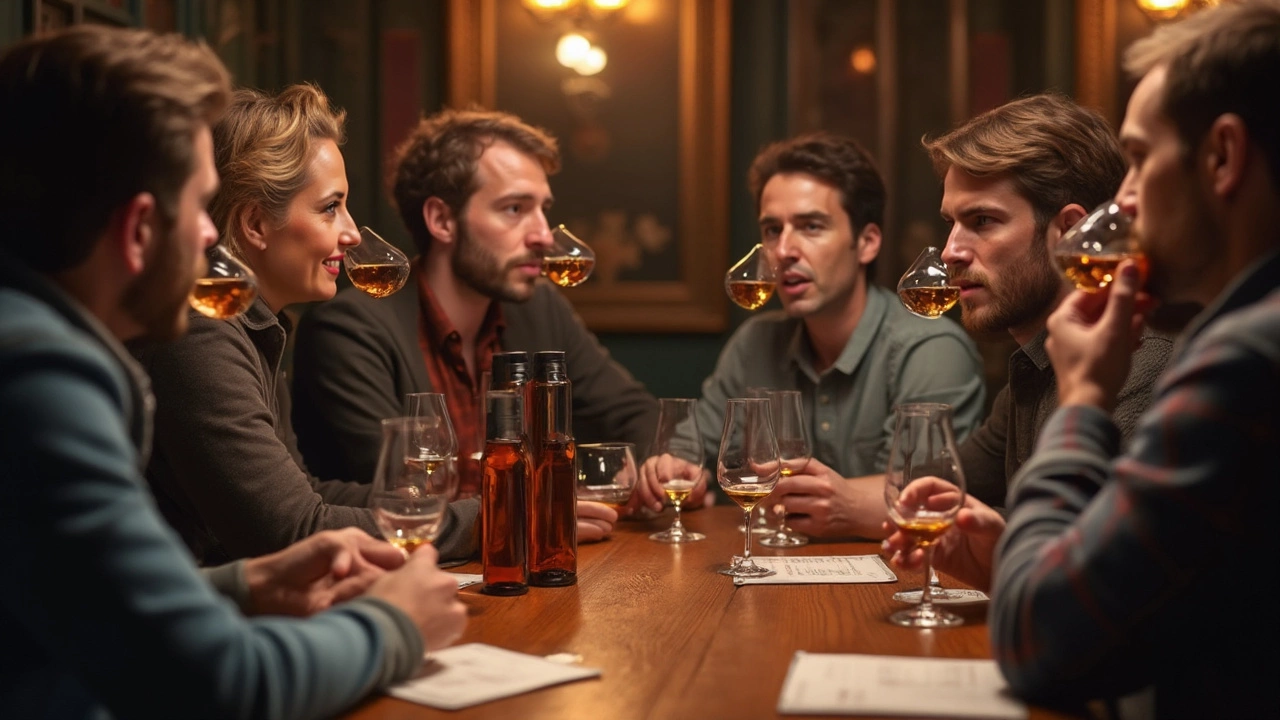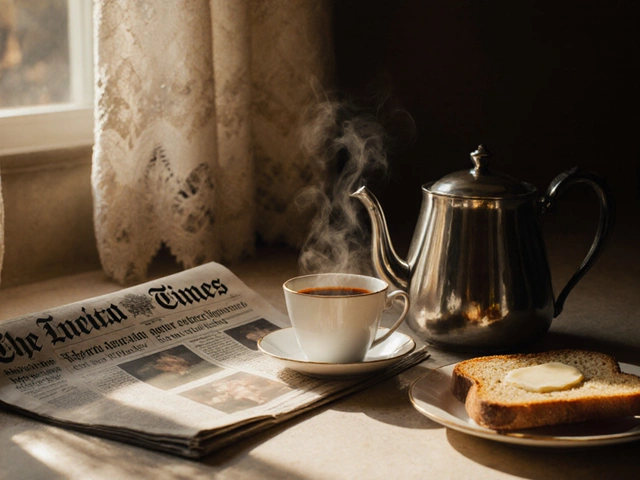If you've ever heard someone talk about the 'nose' of a whisky and thought they were making stuff up, you're not alone. In whisky tasting, 'nose' simply means how the whisky smells. A good sniff can tell you more than a quick sip ever will. Most of what we taste actually comes from our sense of smell, not our tongue.
When people nose whisky, they're searching for specific scents—think vanilla, honey, smoke, or even nail polish remover (yeah, really). These aromas aren't just for show; they give clues about how the whisky was made, how long it sat in a barrel, and what kind of grains were used. Ever notice how some whiskies hit you with a blast of sweet caramel while others lean more earthy or fruity? That's your nose doing the heavy lifting.
Even if you think you have a 'bad nose,' don't worry: you can get better with practice. It all starts with slowing down, taking a careful sniff, and seeing what scents pop out. No fancy background needed. Just pay attention to what you notice, and you'll be amazed at how complex a glass of whisky can get.
- What Does 'Nose' Mean in Whisky?
- How to Properly Nose Whisky
- Common Aromas and What They Tell You
- Tips to Improve Your Nosing Skills
What Does 'Nose' Mean in Whisky?
When people say 'nose' in whisky, they’re talking about the aroma—the way the whisky smells when you bring it up to your nose. It’s not about appearances or the glass itself. Nosing is about picking up all the scents floating over the liquid, which make up a huge part of the tasting experience. In fact, scientists figured out that about 80% of what most folks call taste actually comes from our sense of smell. If your nose is blocked, whisky just won’t taste the same.
Professional tasters, and even casual fans, use nosing to spot all sorts of notes hidden in the drink. These can be things like peat smoke, fresh apples, or butterscotch. It’s almost like whisky has its own secret language of scents. When you hear “the nose is rich with dried fruit and vanilla,” that’s shorthand for what you might smell before you even take a sip.
Nosing matters for more than just tradition. Distillers depend on their noses to make blending decisions, and seasoned drinkers often judge quality based on aroma before anything else. A whisky might look golden and taste alright, but if the nose smells off or harsh, that’s a give-away something went wrong in the process. Here’s a quick rundown of what nosing can reveal:
- Nose: Lets you pick out flavors like caramel, oak, spice, or smoke.
- Shows how mature a whisky is—older whiskies often have deeper, layered scents.
- Reveals faults, like too much alcohol or strange chemical notes, before you even taste it.
To put it into perspective, check out this comparison of common whisky aromas and what they usually mean:
| Aroma Detected | Typical Cause |
|---|---|
| Vanilla | Aged in American oak barrels |
| Smoke | Peated malt or smoky cask |
| Sherry Fruit | Sherry cask aging |
| Sharp Alcohol | Young spirit or rushed distillation |
| Honey | Long, slow fermentation; high-quality grains |
So, the next time you see someone swirling their whisky and sticking their nose in the glass, they’re not showing off—they’re just trying to figure out what kind of story the drink wants to tell. It’s easy to join them once you know what ‘nose’ really means.
How to Properly Nose Whisky
Getting the most out of a glass of whisky starts with nosing it the right way. It might look fancy when people swirl their glasses, but there's real science behind it. Smelling your whisky lets you pick up scents that you might miss if you just start drinking right away. Don't worry if you feel odd at first—this is how the pros do it, and you’ll be surprised by what you can discover.
Follow these steps and you’ll unlock a ton of character from your dram:
- Nose at Room Temperature: Cold whisky can hide aromas, so let it sit and warm up if it’s been in a chilly spot.
- Hold the Glass Right: Use a tulip-shaped glass or Glencairn, which helps focus the smell up to your nose. Avoid wide tumblers if you want to catch all the details.
- Don't Jam Your Nose In: Start by holding the glass a bit below your nose and slowly bring it up. Big deep sniffs can overwhelm your senses, so take light, slow sniffs instead.
- Try With and Without Water: If you think you’re not picking up much, add a few drops of water. This can help open up complex aromas, especially in cask-strength whiskies.
- Give It a Swirl: Gently swirl the glass to release more scents, but don't overdo it. Let the whisky sit for another few seconds so the alcohol doesn’t overpower everything.
It’s completely normal to pick up different things than your friends. Your sense of smell is shaped by what you’ve smelled throughout your life. Compare notes, but trust your own nose.
Just to put it in perspective, experts say humans can distinguish over 1 trillion different odors. When it comes to whisky specifically, the number of possible aroma compounds goes into the hundreds. Here’s a quick look at how temperature and glassware affect what you’ll smell:
| Factor | Aroma Impact |
|---|---|
| Room Temperature | Enhances subtle notes, helps detect full range of aromas |
| Chilled Whisky | Mutes delicate scents, only the strongest aromas come through |
| Tulip or Glencairn Glass | Focuses aroma to your nose |
| Wide Tumbler | Dilutes aroma, making it harder to pick up details |
If you stick to these steps, your whisky tasting experience will change for the better. The aromas are where most of the excitement hides, so give them the attention they deserve.

Common Aromas and What They Tell You
If you crack open any bottle and stick your nose in the glass, certain smells will hit you first. These are so important that professional tasters actually use official lists called aroma wheels, which map out the likely scents you’ll encounter. Most beginners lock onto three big categories: sweet, fruity, and smoky. Each one tells you a little story about how that whisky came to be.
Nose is the main way people spot these differences, and here’s what some top aromas usually mean:
- Vanilla and Caramel: These come from aging whisky in American oak barrels. If you catch these, the whisky likely spent plenty of time in the cask soaking up its sweet notes.
- Fruity: Think apple, pear, raisin, or plum. Fruity notes mainly come from the type of yeast used during fermentation or from sherry casks. Scotch whiskies finished in sherry butts are famous for big hits of dark fruit.
- Peat Smoke: Smells like campfire or smoked bacon. This comes from burning peat during the malting process. Scottish Islay whiskies are known for their bold smoky, earthy aromas.
- Spices: Cinnamon, black pepper, nutmeg. These come from both the barrel and the spirit itself. Rye whiskies are spicy due to the grain, while bourbons often pick up baking spices from the wood.
- Floral: Notice hints of rose, honeysuckle, or cut grass? These usually mean a younger whisky or a single malt made in a lighter style.
- Solvent or Nail Polish Remover: These stronger smells usually point to very young whisky or possible problems in the distillation.
Here's a quick look at how often these scents show up in different whisky types, according to tasting panel research in 2023:
| Aroma | Bourbon (%) | Scotch Single Malt (%) | Rye (%) |
|---|---|---|---|
| Vanilla/Caramel | 82 | 63 | 44 |
| Fruity | 35 | 75 | 29 |
| Peat Smoke | 2 | 68 | 1 |
| Spicy | 59 | 31 | 90 |
| Floral | 12 | 21 | 7 |
| Solvent-like | 9 | 11 | 15 |
If you’re nosing a whisky and get something unexpected, don’t overthink it. Everyone’s sense of smell is different, and your best tools are a curious mind and a willingness to call out what you notice. Over time, these aromas become your favorite clues to unlock what’s in your glass and why it smells the way it does. Take notes—it really helps you connect the dots between scent, cask, and flavor style.
Tips to Improve Your Nosing Skills
You don’t need a ‘super nose’ to spot the unique smells in your glass. A few simple habits can sharpen your sense of smell and make whisky tasting way more fun.
- Start with a clean glass and a neutral room. Strong smells from soaps, candles, or last night’s leftovers can mess up what you detect in your whisky.
- Don’t rush. Swirl the glass gently and give the aroma a minute to release. Sometimes the best scents come after waiting a bit.
- Nose with your mouth slightly open. This lets some aroma hit the back of your throat, making it easier to pick up complex notes.
- Compare different whiskies side by side. Pour two small samples, sniff one, then the other. Your brain is great at noticing contrasts—it makes subtle details stand out.
- Use everyday scents as practice. Smell fresh fruit, vanilla, coffee, or toast at home. When these pop up in whisky, you’ll be faster at spotting them.
If you need a break, sniff your own skin (like your wrist), because your own scent helps “reset” your nose. This trick is used by perfume experts too.
Most folks can detect about 10,000 smells, but whisky tasting can push your limits. Pros sometimes use ‘nosing wheels’—charts that list potential aromas. Here’s a quick look at some common whisky aromas:
| Aroma | Common Source |
|---|---|
| Vanilla | American oak barrels |
| Peat smoke | Dried malted barley |
| Dried fruit | Sherry casks |
| Honey | Natural grain sweetness |
Try to jot down what you smell, even if it’s just “sweet” or “woody” at first. Patterns will emerge the more you practice, turning your average nosing game into a real skill. Before you know it, you’ll be picking out all sorts of cool scents—and sharing them like a pro.


